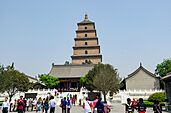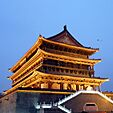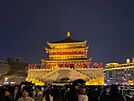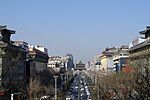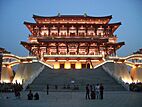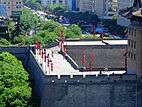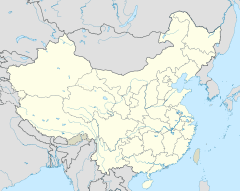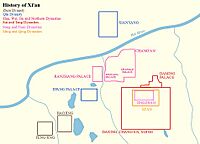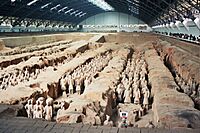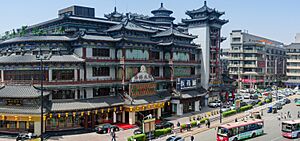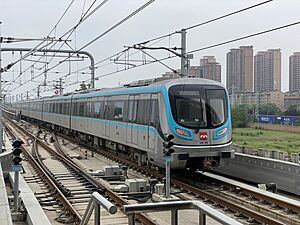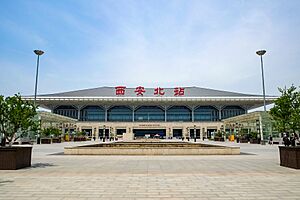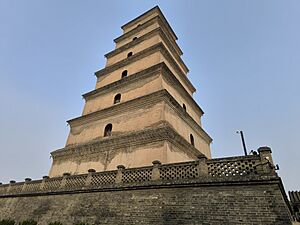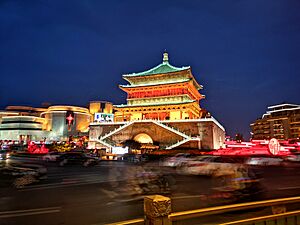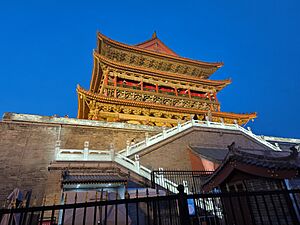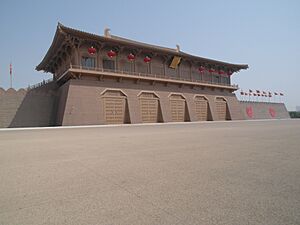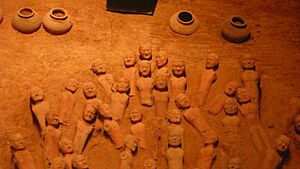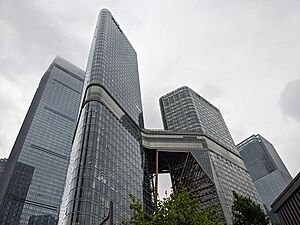Xi'an facts for kids
Quick facts for kids
Xi'an
西安市
Sian, Hsi-an
|
|
|---|---|
|
Subprovincial and prefecture-level city
|
|
|
|
|

Location of Xi'an City jurisdiction in Shaanxi
|
|
| Country | China |
| Province | Shaanxi |
| Municipal seat | Weiyang District |
| Government | |
| • Type | Subprovincial city |
| • Body | Xi'an Municipal People's Congress |
| Area | |
| • Subprovincial and prefecture-level city | 10,762 km2 (4,155 sq mi) |
| • Urban | 5,808.6 km2 (2,242.7 sq mi) |
| • Metro | 4,903.9 km2 (1,893.4 sq mi) |
| Elevation | 405 m (1,329 ft) |
| Population
(2020 census)
|
|
| • Subprovincial and prefecture-level city | 12,952,907 |
| • Density | 1,203.58/km2 (3,117.25/sq mi) |
| • Urban | 11,904,805 |
| • Urban density | 2,049.514/km2 (5,308.22/sq mi) |
| • Metro | 12,283,922 |
| • Metro density | 2,504.929/km2 (6,487.74/sq mi) |
| GDP | |
| • Subprovincial and prefecture-level city | CN¥ 1.201 trillion US$ 154.2 billion |
| • Per capita | CN¥ 98,205 US$ 15,108 |
| Time zone | UTC+8 (CST) |
| Postal code |
710000–710090
|
| Area code(s) | 29 |
| ISO 3166 code | CN-SN-01 |
| License plate prefixes | 陕A,陕U |
| City Flower | Pomegranate flower |
| City Tree | Pagoda tree |
| Website | XA.gov.cn |
| Xī'ān | |||||||||||||||||||||||||||||||||||
|---|---|---|---|---|---|---|---|---|---|---|---|---|---|---|---|---|---|---|---|---|---|---|---|---|---|---|---|---|---|---|---|---|---|---|---|

"Xi'an" in Chinese characters
|
|||||||||||||||||||||||||||||||||||
| Chinese name | |||||||||||||||||||||||||||||||||||
| Chinese | 西安 | ||||||||||||||||||||||||||||||||||
| Postal | Sianfu | ||||||||||||||||||||||||||||||||||
| Literal meaning | "Western Peace" | ||||||||||||||||||||||||||||||||||
|
|||||||||||||||||||||||||||||||||||
| Cháng'ān | |||||||||||||||||||||||||||||||||||
| Simplified Chinese | 长安 | ||||||||||||||||||||||||||||||||||
| Traditional Chinese | 長安 | ||||||||||||||||||||||||||||||||||
| Literal meaning | "Perpetual Peace" | ||||||||||||||||||||||||||||||||||
|
|||||||||||||||||||||||||||||||||||
| Xi'an dialect (Zhongyuan Mandarin) name | |||||||||||||||||||||||||||||||||||
| Xi'an dialect (Zhongyuan Mandarin) | 西安: IPA: [ɕi²¹.ŋã²¹] 長安: IPA: [ʈ͡ʂʰaŋ²⁴.ŋã²¹] |
||||||||||||||||||||||||||||||||||
Xi'an is the capital city of Shaanxi Province in China. It is a very large city located on the Guanzhong Plain. Xi'an is the third most populated city in Western China, after Chongqing and Chengdu. It is also the most populated city in Northwest China. In 2020, its total population was over 12.9 million people.
For much of its history, Xi'an was known as Chang'an. It is one of China's Four Great Ancient Capitals. Many important dynasties in Chinese history made it their capital. These include the Western Zhou, Western Han, Sui, and Tang. Today, Xi'an is a very popular place for tourists to visit in China.
Xi'an is famous as the starting point of the ancient Silk Road. It is also home to the amazing Terracotta Army of Emperor Qin Shi Huang. Both of these are recognized as UNESCO World Heritage sites. Since the 1980s, Xi'an has grown into a major center for culture, industry, education, and research. It is considered a "Beta-" global city, meaning it's a significant city on the world stage.
Contents
- Understanding Xi'an's Name
- Exploring Xi'an's Rich History
- Xi'an's Geography and Climate
- People and Administration in Xi'an
- Getting Around Xi'an: Transportation
- Culture, Food, and Beliefs in Xi'an
- Xi'an's Economy and Industries
- Education and Research in Xi'an
- Exploring Xi'an: Top Tourist Sites
- Sports in Xi'an
- Media in Xi'an
- Xi'an's International Friends
- Images for kids
- See also
Understanding Xi'an's Name
The name "Xi'an" comes from the Chinese words meaning "Western Peace." This name was first used in 1369 during the early Ming dynasty. Older names for the city were "Sian" or "Hsi-an."
The area where Xi'an is today has been home to several important Chinese capitals.
- The Western Zhou capital was called Fenghao.
- The Qin dynasty capital was Xianyang, located nearby.
- The Western Han capital was Chang'an, meaning "Perpetual Peace." This city covered the central part of modern Xi'an.
- During the Sui, the city was called Daxing, meaning "Greatly Prosperous."
- The Tang changed the name back to Chang'an.
- Under the Yuan dynasty, it had names like Fengyuan and Anxi.
Exploring Xi'an's Rich History
Xi'an has a very long and interesting history, going back thousands of years.
Ancient Discoveries and Early Settlements
Scientists found remains of Lantian Man near Xi'an, showing people lived here at least 500,000 years ago. A 6,500-year-old village called Banpo was also found. This village shows that people lived in well-organized communities here a very long time ago. Today, you can visit the Xi'an Banpo Museum to see these ancient finds.
Xi'an became a major cultural and political center around 11th century BC. This was when the Zhou dynasty began. Their capital was in two settlements, Fengjing and Haojing, known as Fenghao. Later, the capital moved to Luoyang due to political problems.
Imperial Era: Dynasties and Great Buildings
After the Warring States period, China was united under the Qin dynasty (221–206 BC). The capital was Xianyang, close to modern Xi'an. The first emperor, Qin Shi Huang, ordered the building of the famous Terracotta Army and his mausoleum.
In 202 BC, Liu Bang started the Han dynasty. He made Chang'an his capital. He built huge palaces like Changle Palace and Weiyang Palace. Weiyang Palace was the biggest palace ever built on Earth. It was much larger than the Forbidden City in Beijing. The first city wall of Xi'an was built around this time. It was very long and thick, protecting a large area.
In 582 AD, the Sui dynasty built a new capital called Daxing. It was the largest city in the world at that time. The Tang dynasty later renamed it Chang'an. During the Tang dynasty, the Buddhist monk Xuanzang returned from India. He set up a school to translate Buddhist scriptures.
The Giant Wild Goose Pagoda was built in 652 AD. It was 64 meters tall and stored Xuanzang's translated scriptures. The Small Wild Goose Pagoda was built later to store more scriptures.
The Nestorian Stele was put up in 781 AD. This stone tablet tells the story of early Christianity in China. It shows that Christian communities existed in northern China during the Tang dynasty.
Chang'an was badly damaged at the end of the Tang dynasty in 904 AD. People were forced to move to a new capital. During the Song dynasty, Xi'an remained an important center for learning and new ideas.
During the Ming dynasty, a new city wall was built in 1370. This wall is still standing today. It is 11.9 kilometers long and very tall and thick. A moat was also built around it for protection.
Modern Xi'an: Recent History and Growth
In the Qing dynasty, special areas were set up for Manchu and Han people within Xi'an. Manchu soldiers from Xi'an were known for keeping their traditional skills.
A major event in 1936 was the Xi'an Incident. During China's civil war, two important leaders were kidnapped in Xi'an. This event helped unite the Kuomintang and Chinese Communist Party. They then worked together to fight against the Imperial Japanese Army in the Second Sino-Japanese War.
During World War II, Japanese planes attacked Xi'an. However, the city was strongly defended and was never captured by Japanese forces. In 1949, the People's Liberation Army took control of Xi'an.
In 2022, Xi'an experienced a large COVID-19 outbreak. The city went into a strict lockdown to control the virus. This caused some challenges for healthcare and food delivery.
Xi'an's Geography and Climate
Xi'an is located on the Guanzhong Plain in central China. This area is a flat plain formed by several rivers. To the south, you can see the Qin Mountains. The Wei River flows to the north of the city. Mount Hua, a sacred Taoist mountain, is also nearby.
Climate of Xi'an
Xi'an has a climate with hot, humid summers and cold, dry winters. Most of the rain falls from July to October. Snow can fall in winter but usually doesn't stay long. Dust storms sometimes happen in spring. Summer also has short thunderstorms. The average temperature in January is around freezing. In July, it's about 27 degrees Celsius (80 degrees Fahrenheit).
People and Administration in Xi'an
In 2010, Xi'an had a population of 5.4 million people. By 2020, the total population grew to nearly 13 million. The city is divided into 11 districts and 2 counties. Each of these areas has its own local government.
| Division | Permanent residents | Hukou residents | ||
|---|---|---|---|---|
| Total | Percentage | Population density (persons/km2) | ||
| Xi'an City | 8,467,837 | 100 | 838.66 | 7,827,260 |
| Xincheng District | 589,739 | 6.96 | 19,574.51 | 503,641 |
| Beilin District | 614,710 | 7.26 | 26,298.54 | 732,494 |
| Lianhu District | 698,513 | 8.25 | 18,226.61 | 640,911 |
| Baqiao District | 595,124 | 7.03 | 1,833.97 | 508,535 |
| Weiyang District | 806,811 | 9.53 | 3,051.39 | 516,968 |
| Yanta District | 1,178,529 | 13.92 | 7,782.38 | 793,103 |
| Yanliang District | 278,604 | 3.29 | 1,139.26 | 252,449 |
| Lintong District | 655,874 | 7.75 | 716.04 | 697,586 |
| Chang'an District | 1,083,285 | 12.79 | 681.94 | 980,803 |
| Gaoling District | 333,477 | 3.94 | 1,169.98 | 294,507 |
| Huyi District | 556,377 | 6.57 | 434.87 | 597,071 |
| Lantian County | 514,026 | 6.07 | 256.25 | 643,605 |
| Zhouzhi County | 562,768 | 6.65 | 191.08 | 665,587 |
Getting Around Xi'an: Transportation
Xi'an is a city where it's easy to get around. Many areas have special paths for walking. You'll find underpasses and overpasses for pedestrians, especially in busy shopping areas.
A bicycle sharing system started in 2013. Now, there are 52,000 bikes used by over 200,000 people daily. Taxis are common, but many people use the city's large bus network. Over 7,800 buses run on 270 routes, carrying more than 4 million people every day. The city also has a growing subway system.
Xi'an Metro: Riding the Subway
The Xi'an Metro is a fast way to travel.
- Line 2 was the first to open in 2011. It runs from north to south.
- Line 1 opened in 2013, going from west to east.
- Line 3 opened in 2016, connecting the northeast to the southwest.
- Line 4 opened in 2018, running mostly parallel to Line 2.
- Line 5 opened in 2020, covering 41.6 kilometers.
- Line 16 opened in 2023. More lines are being built.
The subway connects to many famous places. You can reach the Banpo Museum, Bell and Drum Tower, Fortifications of Xi'an, and the Giant Wild Goose Pagoda.
Rail Travel: Trains in Xi'an
Xi'an has a major train station just north of its old city wall. The new Xi'an North railway station is for high-speed trains. It's the largest railway station in Northwest China. High-speed trains connect Xi'an to cities like Zhengzhou and Baoji very quickly.
Air Travel: Xi'an Xianyang International Airport
Xi'an Xianyang International Airport is the main airport for the city. It's the biggest airport in northwestern China. Many major airlines use this airport. It has flights to most Chinese cities and several big cities in Asia.
Culture, Food, and Beliefs in Xi'an
Xi'an has a rich culture, delicious food, and diverse religions.
Local Artists and Music
Xi'an is home to famous Chinese musicians. These include Xu Wei, Zhang Chu, and Zheng Jun.
Delicious Xi'an Cuisine
Xi'an is known for its unique and tasty dishes.
- Yangrou paomo is a famous dish. It's flatbread soaked in lamb soup.
- Liang pi are cold rice noodles. They are served with vinegar and chili oil.
- Biangbiang mian are thick, hand-pulled noodles. They are often served with spicy red pepper.
- Roujiamo are meat buns. They are buns filled with savory pork.
Qinqiang Opera
Qinqiang is a very old type of Chinese opera. It's also called the "Voice of Qin." Another famous show is "Empress of the Great Tang." This show uses music and dance to tell the story of Empress Wu Zetian of the Tang dynasty.
Traditional Religions and Taoism
Many people in Xi'an follow traditional Chinese religions and Taoism. There are many temples in the city. These include a City God Temple and a Temple of Confucius.
Christianity in Xi'an
The first Christian missionary to China, Alopen, arrived in Xi'an (then Chang'an) in 635 AD. The Nestorian Stele in Xi'an's Beilin Museum tells about early Christian communities. It shows that the Christian church was recognized by the Tang Emperor Taizong.
Islam in Xi'an
Xi'an has a Muslim community, mostly from the Hui group. There are about 50,000 Hui Muslims in Xi'an. The most famous mosque is the Great Mosque of Xi'an. It's one of the oldest and most important mosques in China. It mixes Islamic and traditional Chinese building styles.
Xi'an's Economy and Industries
Xi'an's economy has grown a lot, especially since 1997. It's the biggest economy in Shaanxi province. Many international companies have set up businesses in Xi'an. These include Mitsubishi, Panasonic, Coca-Cola Company, and Boeing.
Xi'an is a "Beta-" global city and one of the world's top 100 financial centers. Important industries include manufacturing, tourism, and service outsourcing. Tourism is very important because of Xi'an's many historical sites. In 2019, over 300 million tourists visited Xi'an.
Xi'an is also a leader in the software industry in China. The Xi'an Software Park has attracted many companies and employees. The city also has a growing aerospace industry. This industry focuses on developing satellites and new technologies for everyday use.
Education and Research in Xi'an
Xi'an has many excellent universities. There are 60 universities in the city.
- Xi'an Jiaotong University is one of the most famous.
- Other important universities include Northwestern Polytechnical University and Xidian University.
Xi'an is a world leader in scientific research. In 2023, it was ranked among the top 20 cities globally for scientific research. It was also the top city in West China for research output.
Exploring Xi'an: Top Tourist Sites
Xi'an is a fantastic place for tourists because of its many historical sites. There are ancient ruins, tombs, and museums to explore.
Some of the most famous places to visit in Xi'an are:
- The well-preserved city wall. It was rebuilt in the 14th century.
- The Mausoleum of Qin Shi Huang and his incredible Terracotta Army. They are located just outside the city center.
- The Bell Tower and Drum Tower. These are in the very center of the city.
- The Muslim Quarter, home to the beautiful Great Mosque of Xi'an.
- The Giant Wild Goose Pagoda and Small Wild Goose Pagoda. These ancient towers are over 1,000 years old.
- The Stele Forest, famous for its historical stone carvings.
- The Famen Temple and its tall pagoda.
- The Banpo Neolithic village, showing ancient life.
- The Shaanxi History Museum, with many historical artifacts.
- The Xi'an Museum, located near the Small Wild Goose Pagoda.
- Huaqing Hot Springs, a historic site with a palace.
- Daming Palace National Heritage Park, the site of former royal residences.
Sports in Xi'an
Xi'an has been home to several professional sports teams in the past. These include:
- Shaanxi National Power (football)
- Shaanxi Baorong Chanba (football)
- Shaanxi Dongsheng (basketball)
Media in Xi'an
You can watch national TV channels like China Central Television in Xi'an. Shaanxi Television (SXTV) is the local provincial station. Shaanxi Radio broadcasts music and news.
Xi'an's International Friends
Xi'an has many twin towns and sister cities around the world. These partnerships help build friendships and understanding between different cultures.
|
Images for kids
-
Meibei Lake, Huyi District, Xi'an
See also
 In Spanish: Xi'an para niños
In Spanish: Xi'an para niños


